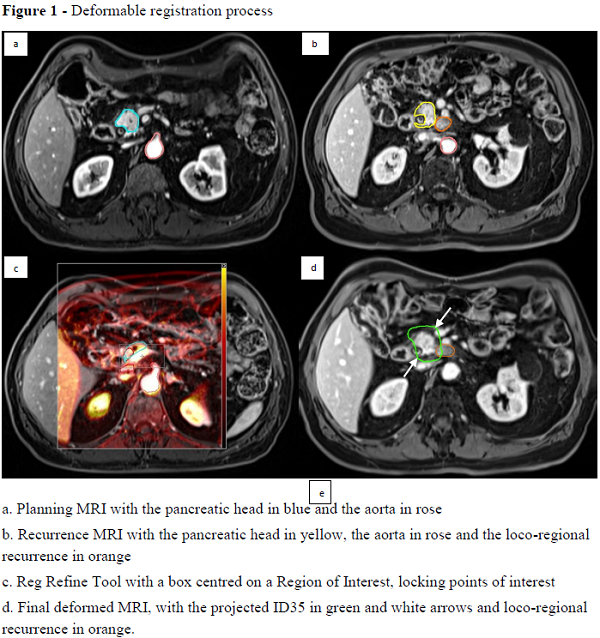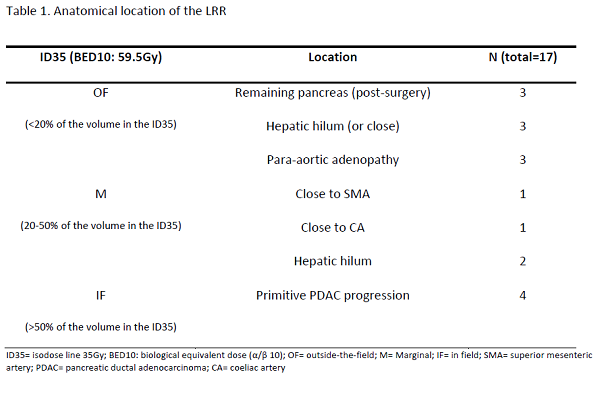Evaluation of loco-regional recurrences using DIR after iHD-SBRT in localised pancreatic cancer
Martin Manderlier,
Belgium
PO-1380
Abstract
Evaluation of loco-regional recurrences using DIR after iHD-SBRT in localised pancreatic cancer
Authors: Martin Manderlier1, Sara Poeta2, Jean-Luc Engelholm3, Dirk Van Gestel1, Jean-Luc Van Laethem4, Luigi Moretti1, Akos Gulyban2, Christelle Bouchart1
1HUB Institut Jules Bordet, Department of Radiation Oncology, Brussels, Belgium; 2HUB Institut Jules Bordet, Medical Physics Department, Brussels, Belgium; 3Hopitaux Iris Sud, Department of Radiology, Brussels, Belgium; 4Hôpital Universitaire Erasme, Department of Gastroenterology, Hepatology and Digestive Oncology, Brussels, Belgium
Show Affiliations
Hide Affiliations
Purpose or Objective
To perform an imaging-based clinical evaluation of the loco-regional recurrence (LRR) pattern after isotoxic high dose stereotactic body radiotherapy (iHD-SBRT) for localised pancreatic cancer using deformable image registration (DIR).
Material and Methods
From January 2018 to January 2021, patient with borderline/locally advanced (BR/LA) pancreatic adenocarcinoma were included. Cases without clearly identified LRR after a total neoadjuvant strategy were excluded. The neoadjuvant treatment was composed of induction chemotherapy (modified FOLFIRINOX) followed by iHD-SBRT (35Gy in 5 fractions with a simultaneous integrated boost up to 53Gy) and surgical exploration (if operable and no progression)¹. No elective nodal irradiation was used for iHD-SBRT and a tumour-vessels interface (TVI) structure was created by including the whole circumference of major abdominal vessels in direct contact with the GTV. During the follow-up, LRR were identified on CT or MRI. The same imaging modalities of LRR and RT-planning were imported in MIM (v7.1.5, MIMvista Inc, Cleveland, OH, USA), delineating the following structures : major abdominal great vessels, pancreas, primary tumour and LRR (only on the latter image set). A tailored DIR procedure was performed and validated (using qualitative and visual assessment) prior the back propagation of the LRR to the initial imaging. Finally, the 35Gy isodose line of the initial plan was used to classify the back-propagated LRRs as: in-field (IF), marginal and out-of-field (OF). (Figure1)

Results
Among 41 patients treated by iHD-SBRT for localized pancreatic cancer, a LRR was clearly identified in 17 patients (ten on CT and seven on MRI). The tailored DIR workflow confirmed plausible correspondence between the two image sets. The majority of the LRR were classified as OF (n=9), while four cases were identified as IF and the remaining four as marginal recurrences close to major abdominal vessels (table 1).

Conclusion
Imaging based evaluation of loco-regional recurrence is an important part of the assessment of a neoadjuvant treatment strategy including iHD-SBRT for localised pancreatic cancer. Based on the tailored deformable image registration, four marginal LRR occurred, close to the vessels around the primary tumour. This highlight the need to include the whole circumference of the major abdominal vessels in direct contact with the GTV in the TVI structure, with at least 5mm margin on both sides of the GTV, in order to further minimize the risk of marginal LRR after iHD-SBRT.
1 Bouchart C, Engelholm JL, Closset J et al. Isotoxic high-dose stereotactic body radiotherapy integrated in a total multimodal neoadjuvant strategy for the treatment of localized pancreatic ductal adenocarcinoma. Ther Adv Med Oncol 2021; 13: 17588359211045860.